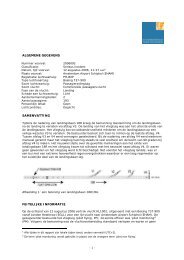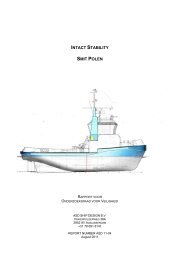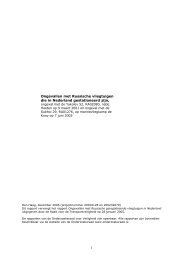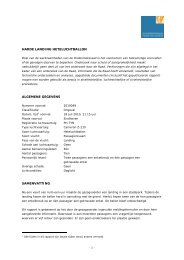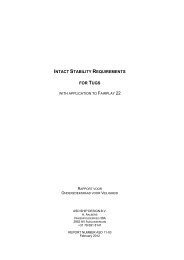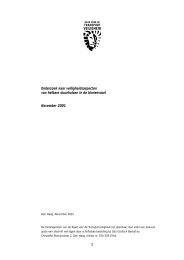Rejected takeoff after the takeoff decision speed 'V ', Boeing B737 ...
Rejected takeoff after the takeoff decision speed 'V ', Boeing B737 ...
Rejected takeoff after the takeoff decision speed 'V ', Boeing B737 ...
Create successful ePaper yourself
Turn your PDF publications into a flip-book with our unique Google optimized e-Paper software.
2 FACTUAL INFORMATION<br />
2.1 INTRODUCTION<br />
This chapter presents <strong>the</strong> essential facts to determine <strong>the</strong> causes and answer <strong>the</strong> investigative<br />
questions regarding <strong>the</strong> rejected <strong>takeoff</strong> event. In section 2.2 background information is given on<br />
<strong>the</strong> aviation ‘V-<strong>speed</strong>s’. In section 2.3 <strong>the</strong> relevant technical systems of <strong>the</strong> <strong>Boeing</strong> 737-800 are<br />
briefly discussed. Section 2.4 describes <strong>the</strong> history of flight. Section 2.5 through 2.10 describe<br />
o<strong>the</strong>r factual information which is required for <strong>the</strong> subsequent analysis of <strong>the</strong> event.<br />
2.2 BACKGROUND INFORMATION<br />
In aviation, V-<strong>speed</strong>s or velocity-<strong>speed</strong>s are standard terms used to define air<strong>speed</strong>s important or<br />
useful for operating an aircraft. These <strong>speed</strong>s are derived from data obtained by aircraft designers<br />
and manufacturers during aircraft flight testing and certification. In some cases <strong>the</strong> V-<strong>speed</strong>s are<br />
specified in <strong>the</strong> certification specifications. Using <strong>the</strong>se <strong>speed</strong>s is considered best practice and<br />
maximises aviation safety, aircraft performance or both.<br />
The <strong>speed</strong> V 1<br />
is an operational <strong>speed</strong> which is used for <strong>takeoff</strong>. Several definitions exist for <strong>the</strong> V 1<br />
<strong>speed</strong>, some from an operational perspective o<strong>the</strong>rs from a certification point of view (in appendix<br />
B examples are given). V 1<br />
is defined in <strong>the</strong> Flight Crew Operations Manual used by this operators<br />
flight crews as <strong>the</strong> “<strong>takeoff</strong> <strong>decision</strong> <strong>speed</strong>”.<br />
The <strong>speed</strong> V 1<br />
is used during <strong>takeoff</strong> to aid <strong>the</strong> pilots <strong>decision</strong> making process in <strong>the</strong> event of an<br />
engine failure or o<strong>the</strong>r significant problem. Below V 1<br />
, <strong>the</strong> aircraft is able to stop within <strong>the</strong> available<br />
runway distance, whereas above V 1<br />
it is uncertain or unable to do so. Attempting to stop above<br />
V 1<br />
is considered hazardous due to <strong>the</strong> possibility of overrunning <strong>the</strong> end of <strong>the</strong> runway. If <strong>the</strong><br />
runway distance for reaching V 1<br />
is equal to <strong>the</strong> remaining runway distance, <strong>the</strong> <strong>takeoff</strong> is called a<br />
balanced field <strong>takeoff</strong> 2 . The chance for an overrun is especially high when a balanced field <strong>takeoff</strong><br />
is performed.<br />
The wea<strong>the</strong>r, weight of <strong>the</strong> aircraft, <strong>the</strong> runway altitude, conditions and length affect <strong>the</strong> V 1<br />
<strong>speed</strong>.<br />
During flight testing, for a range of <strong>takeoff</strong> weights, <strong>the</strong> V 1<br />
<strong>speed</strong>s are determined which are <strong>the</strong>n<br />
published in <strong>the</strong> flight manual. This information in <strong>the</strong> flight manual is <strong>the</strong>n used by <strong>the</strong> flight crew<br />
to determine <strong>the</strong> V 1<br />
<strong>speed</strong> for each <strong>takeoff</strong>.<br />
In addition to <strong>the</strong> V 1<br />
<strong>speed</strong>, <strong>the</strong> <strong>speed</strong>s at which <strong>the</strong> pilot flying should start rotation (V R<br />
) 3 and<br />
<strong>the</strong> <strong>takeoff</strong> safety <strong>speed</strong> (V 2<br />
) 4 are determined. These <strong>speed</strong>s are established by flight testing and<br />
published in <strong>the</strong> flight manual. All three of <strong>the</strong> V-<strong>speed</strong>s are determined by <strong>the</strong> flight crew for each<br />
<strong>takeoff</strong>.<br />
2 A balanced field <strong>takeoff</strong> is a condition where <strong>the</strong> accelerate-stop distance required (ASDR) is equal to<br />
<strong>the</strong> <strong>takeoff</strong> distance required (TODR) for <strong>the</strong> aircraft weight, engine thrust, aircraft configuration and<br />
runway condition. In general, <strong>the</strong> balanced field length represents <strong>the</strong> minimum runway length that can<br />
be used for <strong>takeoff</strong>.<br />
3 V R<br />
is <strong>the</strong> <strong>speed</strong> at which <strong>the</strong> pilot flying starts pulling on <strong>the</strong> controls causing <strong>the</strong> aircraft to pivots<br />
around <strong>the</strong> axis of its main landing gears which are, at that time, on <strong>the</strong> ground.<br />
4 V 2<br />
is <strong>the</strong> <strong>speed</strong> is <strong>the</strong> <strong>speed</strong> required to maintain a minimum climb gradient with one engine-out.<br />
7








